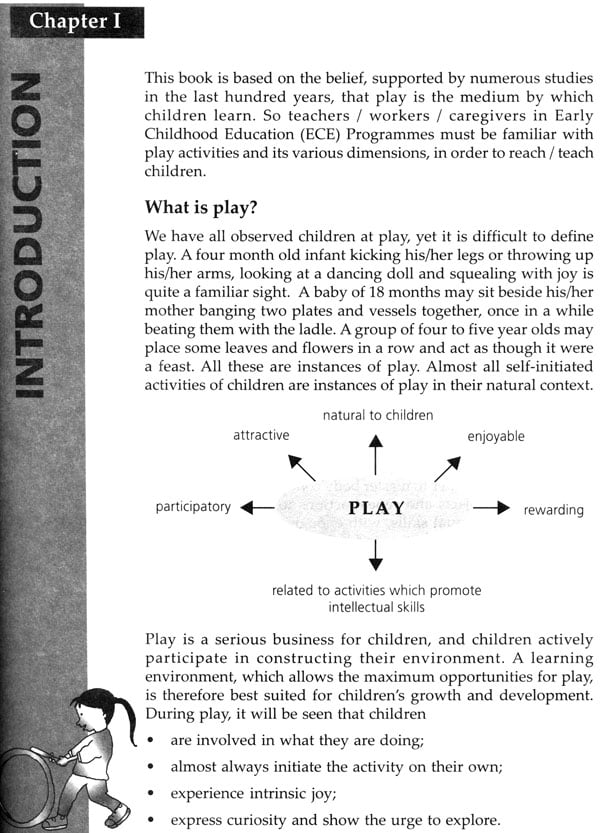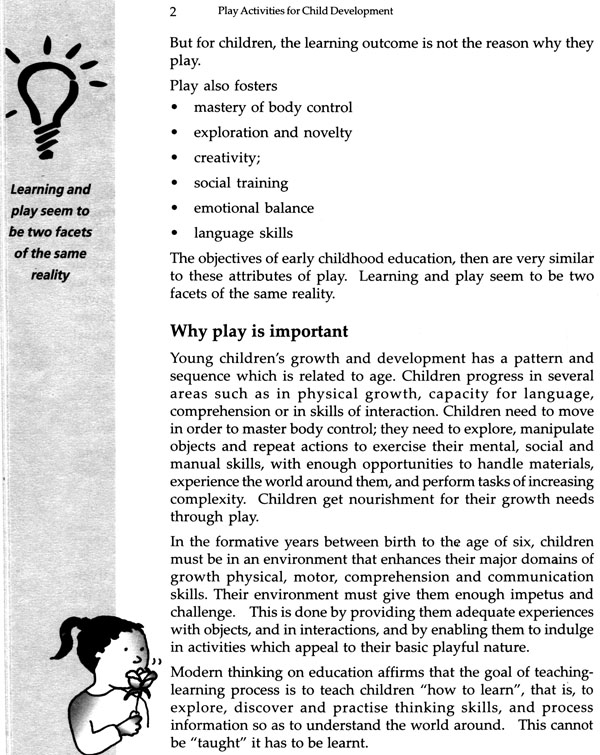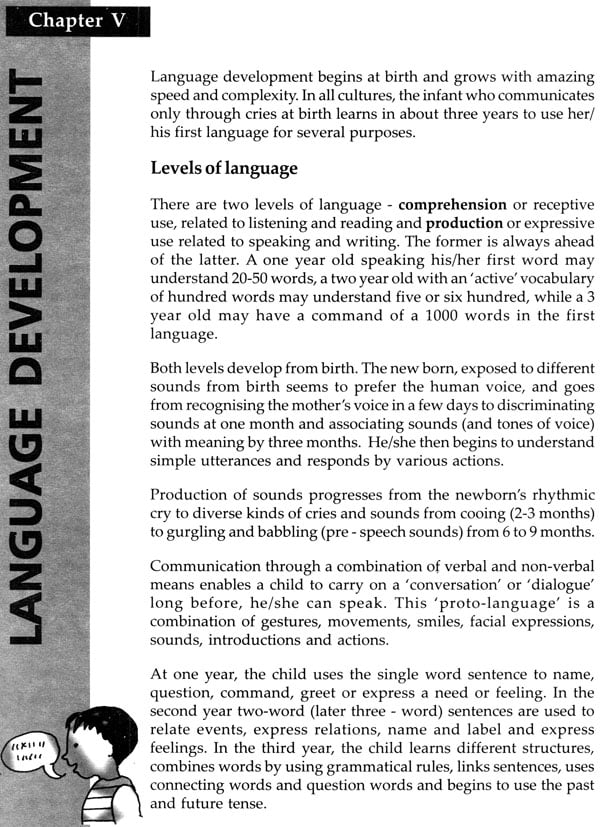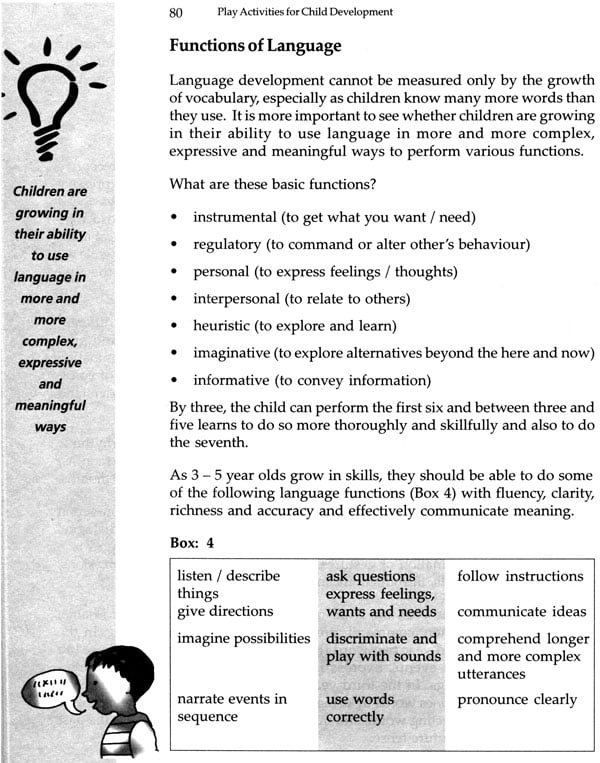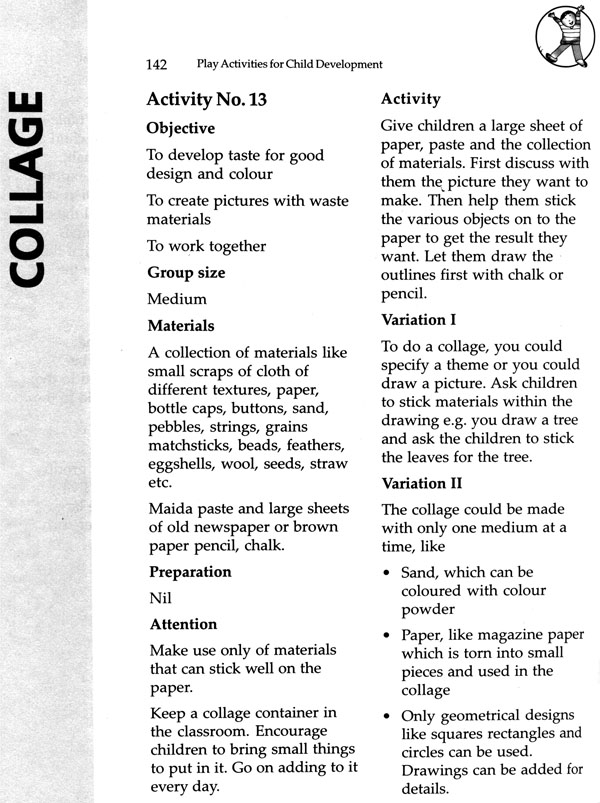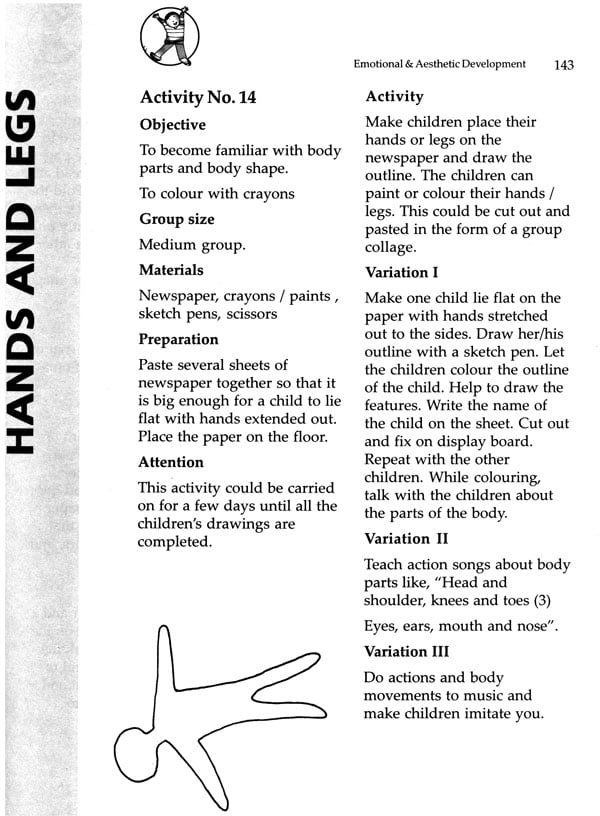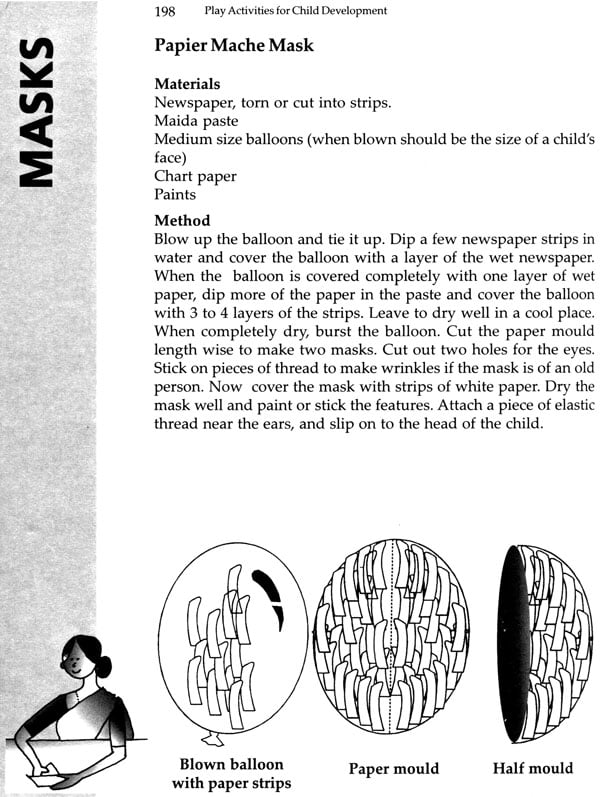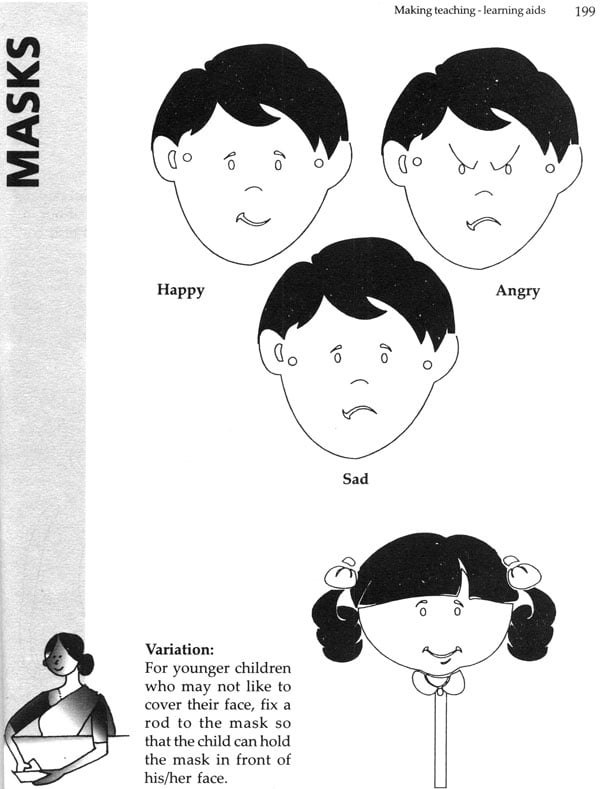
Play Activities for Child Development (A Guide to Pre-School Teachers)
Book Specification
| Item Code: | IDL209 |
| Author: | Mina Swaminathan and Prema Daniel |
| Publisher: | National Book Trust, India |
| Language: | English |
| Edition: | 2009 |
| ISBN: | 9788123742205 |
| Pages: | 214 |
| Cover: | Paperback |
| a54_books | |
| Other Details | 9.5" X 7.3" |
Book Description
Back of the Book
This is an easy-to-use handbook of nearly two hundred play activities for young children in the age-group of 3 to 5. All the activities are arranged in seven groups, according to different domains of development with a separate chapter on classroom organization and management. The book is illustrated profusely.
Mina Swaminathan has been a classroom teacher of young children and later a teacher educator, programme manager and policy adviser in Early Childhood Care an Education for more than four decades.
Prema Daniel, a post-graduate in Child Development, has vast practical experience of teaching young children. She has been involved in teacher-education programmes as well.
Preface
This book has grown out of the manual Play Activities for Young Children originally developed by the first author in 1983 and published by UNICEF in 1984. the manual was part of UNICEF’s support for improving the quality of the preschool education component in ICDS, which, already about ten years old and massive in reach, was even then seen to be less than adequate in quality. Its dissemination was very wide: the first edition of 1,50,000 reaching anganwadi workers in the Hindi speaking and - knowing areas of the study, and 7000 copies being used by trainers and supervisors. Later on, other Indian language editions (Tamil, Malayalam, and Oriya), of several thousands each, were prepared in various States, again with the support of UNICEF. The manual, which is now out of print, has thus been widely distributed and used, and the feedback from the field, mostly of an anecdotal kind, has been very positive. At any rate, the first author has found, in the course of her travels, that she is easily recognized as a friend, guide, and mentor, and warmly welcomed by anganwadi workers everywhere in India. And, from the early 1990s, UNICEF has been asking for a revised and improved version (though it has taken another decade to bring that intention to fulfillment).
Since the manual was for free distribution directly by Government, it could not be made available to teachers and institutions in other sectors, nor could it be made freely obtainable as a priced publication on the open market. However, many workers in ECE in the non-governmental sector (that is, those teaching in private schools and in balwadis run by NGOs) who have seen it, have been highly appreciative and enthusiastic about using it.
This is what gave us the idea of jointly developing a revised, enriched, and more systematic version of the original, and of trying to make it widely available as a priced publication, preferably low-cost, available on the open market to all teachers who are interested in learning more and improving their skills. With this in mind, we started work in 1998 and completed the first draft of the manuscript in its present form, with much encouragement from professional friends and well-wishers. But ironically, while professional sppreciate the pressing need for such a manual, the need does not seem to translate into market demand. It seems that the majority of private schools in India are not interested in play-based or developmentally-appropriate curriculum for young children, and prefer other approaches that we can only say we abhor as being contradictory to known principles of pedagogy and child development. This is because ECE in India, having been totally unrecognized till very recently, has been quite unregulated – there are no broadly accepted or laid-down guidelines, standards, or norms regarding what should be taught and, even more importantly, how it should be taught. The very few who are interested and supportive are obviously not enough to constitute a market, in terms that make sense of publishers. Hence, though the first draft of the present book was ready by early 1999, we spent more than three years trying to get leading educational publishers (in English) interested. Our efforts, ranging from outright rejection to varying levels of negotiation, ended in failure, but we also discovered that, had we succeeded, the price of the book would have made it prohibitive for those we were most interested in reaching. So we are immensely grateful to the National Book Trust for having the vision and daring to bring out a book that meets “needs” that do not generate “demand”. Even more so, because we know that, in due course, many Indian language editions will be published and find their way to those who are interested and need them, if they learn to make themselves heard.
The basic concept underlying this manual, which is addressed directly to the classroom teacher or childcare worker, is that of “developmental appropriateness.” We have used the same idea in the Activity-based Developmentally-appropriate Curriculum for Young Children, also our joint venture, published by the Indian Association for Preschool Education, Chennai. Hence, we have chosen to go about it by briefly delineating the various domains of development and then presenting a set of activities that could help foster the child’s development of concepts, skills, attitudes, and behaviours in those domains. The forms the core of the manual, which then goes on to deal with some of the organizational issues that teachers have to be concerned with. The plan of the manual, which then goes on to deal with some of the organizational issues that teachers have to be concerned with. The plan of the book is reader-friendly: each major section deals with one domain of development, starting with a short theoretical introduction and followed by a set of activities. This makes it possible for the teacher to go straight to the activity of choice, making use of the theory as and when required. The activities themselves are laid out in a uniform format, making it easy for the teacher, once familiar with the approach, not only to quickly find what is needed but also to understand it easily. The language is simple and direct, and the examples are chosen to stimulate the teacher to think of more activities; while the appendix contains carefully illustrated instructions for making teaching-learning aids, toys, and play materials. There is no special order in which the various domains –or the activities-have to be taken up, and the book can be dipped into and used flexibly. In fact, it is meant to be used like a resource and reference book, and not like a textbook to be read from one end to the other in a prescribed order. Hopefully, this would make it the classroom teacher’s friend and companion. And, if it does, that would be our best reward.
Working together on this book, with all its ups and downs, has been a most enjoyable and rewarding experience for both of us. One of our pleasant tasks is to express our deep debt of gratitude to all those who have encouraged, helped, and supported us in various ways:
UNICEF, for bringing out the earlier version of this book in 1984.
Bernard van Leer Foundation, for encouraging us to revised the book through a small seeding grant in 1998, as part of the project Operation Resource Support.
Mini Krishnan, friend, guide and adviser, for timely advice, moral support, optimism, and faith in us even when things seemed at their most bleak
Usha Aroor, for suggesting the basic design and format of this version
Sheela Subramaniam, for her skilled and patient editing
Varsha Das, formerly Director of the National Book Trust, for her warm appreciation, and acceptance of the book for publication during her term.
Sheela Pankaj, for constant support over the years in typing several drafts of the manuscript, handling all the details, and seeing us through to the end.
A. Sakthi Velan, for help and support in typing the manuscript.
Mallika Badrinath, our designer, for her creativity and perseverance in enriching the text with both meaning and visual delight.
Our editors at NBT, Dr. Baldev Singh ‘Baddan,’ Chief Editor and Joint Director and Dr. Srirang K. Jha, Series in-charge, for the care, concern, and skill with which this book has been handled, and.
Last, but not least, to all the professional friends and colleagues who, over the years and till today, have contributed to our learning through many shared experiences and meaningful discussions.
Without each one of them, this book would never have been possible.
| I | INTRODUCTION | 1 |
| II | PHYSICAL DEVELOPMENT | 11 |
| Introduction | ||
| 1 | Taking Big Steps | 14 |
| 2 | Walk like Animals | 15 |
| 3 | Rope Walk | 16 |
| 4 | Rope Train | 17 |
| 5 | Walk Along the Shape | 18 |
| 6 | In and Out | 19 |
| 7 | Balancing Board | 20 |
| 8 | Catch Me if You Can | 21 |
| 9 | Races | 22 |
| 10 | Curving Race | 23 |
| 11 | Throw a Ball | 24 |
| 12 | Roll a Ball | 25 |
| 13 | Bounce the Ball | 26 |
| 14 | Kick the Ball | 27 |
| 15 | Do it Differently | 28 |
| 16 | Old Tyres | 29 |
| 17 | Musical Chairs | 30 |
| 18 | The Dog and the Bone | 31 |
| 19 | Musical Islands | 32 |
| 20 | Is the Lamb at Home? | 33 |
| III | SENSORY AND MOTOR DEVELOPMENT | 34 |
| Introduction | ||
| 1 | I Hear a Sound | 36 |
| 2 | Loud and Soft | 37 |
| 3 | Body Sounds | 38 |
| 4 | Sounds of Objects | 39 |
| 5 | Guess My Smell | 40 |
| 6 | Guess My Taste | 41 |
| 7 | Soft and Hard | 42 |
| 8 | Touch Cards | 43 |
| 9 | Count Without Looking | 44 |
| 10 | Blindfold Walk | 45 |
| 11 | Stuffed Animals | 46 |
| 12 | Tear it Up | 47 |
| 13 | Nature Walk – Listen, See, Feel | 48 |
| 14 | Rangoli | 49 |
| 15 | Finger Painting | 50 |
| 16 | Clay | 51 |
| 17 | Sand | 52 |
| 18 | Water | 53 |
| 19 | Make a Necklace | 54 |
| 20 | The Five Senses | 55 |
| IV | COGNITIVE DEVELOPMENT | 56 |
| Introduction | ||
| 1 | Sorting by Size | 59 |
| 2 | Guess What ? | 60 |
| 3 | Bingo | 61 |
| 4 | Match the Domino | 62 |
| 5 | The Right Partner | 63 |
| 6 | Match and Mismatch | 64 |
| 7 | Missing Pictures | 65 |
| 8 | Which is Faster? | 66 |
| 9 | Mystery Game | 67 |
| 10 | Arrange in a Line | 68 |
| 11 | Shadow Play | 69 |
| 12 | Collect, Bring and Arrange | 70 |
| 13 | Things to Do with Trees | 71 |
| 14 | Floating and Sinking | 72 |
| 15 | Filling the Bottles | 73 |
| 16 | Jig-Saw Puzzles | 74 |
| 17 | Complete a Person | 75 |
| 18 | Design | 76 |
| 19 | Conditions | 77 |
| 20 | Sensitive Puppet | 78 |
| V | LANGUAGE DEVELOPMENT | 79 |
| Introduction | ||
| 1 | Hot and Cold | 82 |
| 2 | Magic Bag | 83 |
| 3 | Who’s There? | 84 |
| 4 | Show and Tell | 85 |
| 5 | Rhyming Words | 86 |
| 6 | Add a Word | 87 |
| 7 | Listen to Me | 88 |
| 8 | Left and Right | 89 |
| 9 | Family Names | 90 |
| 10 | Do as I do and Not as I Say | 91 |
| 11 | Who am I? | 92 |
| 12 | Detective Game | 93 |
| 13 | Riddles | 94 |
| 14 | Picture Reading | 95 |
| 15 | Story Telling | 96 |
| 16 | Let’s Act a Story | 97 |
| 17 | What Happened Next? | 98 |
| 18 | Let’s Take a Trip | 99 |
| 19 | Finger Play | 100 |
| 20 | I Can Do | 101 |
| VI | SOCIAL AND PERSONAL DEVELOPMENT | 102 |
| Introduction | ||
| 1 | Copy Cat | 106 |
| 2 | Happy Hands | 107 |
| 3 | Say Hello | 108 |
| 4 | Drawing Race | 109 |
| 5 | Special Helper | 110 |
| 6 | Where’s your Bone? | 111 |
| 7 | I’m Happy Book | 112 |
| 8 | Let’s Share | 113 |
| 9 | Make your Face | 114 |
| 10 | I am Important | 115 |
| 11 | Roll a Ball | 116 |
| 12 | Clean Corner | 117 |
| 13 | Back to Back | 118 |
| 14 | Be Quick | 119 |
| 15 | Call your Friends | 120 |
| 16 | Zip Zap | 121 |
| 17 | Snakes and Ladders | 122 |
| 18 | Helping Others | 123 |
| 19 | Good Habits | 124 |
| 20 | The Leader | 125 |
| VII | EMOTIONAL AND AESTHETIC DEVELOPMENT | 126 |
| Introduction | ||
| 1 | Statues | 130 |
| 2 | Move in Rhythm | 131 |
| 3 | How Would You Feel? | 132 |
| 4 | Follow the Sound | 133 |
| 5 | What am I Doing? | 134 |
| 6 | Fast and Slow | 135 |
| 7 | Through the Maze | 136 |
| 8 | Fun with Crayons | 137 |
| 9 | Murals | 138 |
| 10 | Card Embroidery | 139 |
| 11 | Colour and Wax Resist | 140 |
| 12 | Wet Chalk Drawing | 141 |
| 13 | Collage | 142 |
| 14 | Hands and Legs | 143 |
| 15 | Painting With a Difference | 144 |
| 16 | Printing | 145 |
| 17 | Paper Folding (Origami) | 146 |
| 18 | Paper Flowers | 147 |
| 19 | Common Objects | 148 |
| 20 | Story with a Difference | 149 |
| VIII | READINESS FOR THE 3 R’S | 150 |
| Introduction | ||
| 1 | Bank | 154 |
| 2 | Clapping Numbers | 155 |
| 3 | Counting Race | 156 |
| 4 | Act the Number | 157 |
| 5 | Sum Race | 158 |
| 6 | Track Race | 159 |
| 7 | Sum Race | 160 |
| 8 | Read a Calendar | 161 |
| 9 | Measurement | 162 |
| 10 | Posting Shapes | 163 |
| 11 | Posting Letters | 164 |
| 12 | Who is Wrong? | 165 |
| 13 | Help Me | 166 |
| 14 | Picture Word Matching | 167 |
| 15 | Classroom News | 168 |
| 16 | Read and Act | 169 |
| 17 | Flannel Board Shapes | 170 |
| 18 | Crosses | 171 |
| 19 | Draw on the Road | 172 |
| 20 | One to One | 173 |
| IX | MANAGING PLAY ACTIVITIES | 174 |
| 1 | Organising Space | 174 |
| 2 | Organising Equipment and Materials | 175 |
| 3 | Organising Time | 182 |
| 4 | Organising Activities | 186 |
| X | EVALUATION | 192 |
| 1 | Assessing the Programme | 192 |
| 2 | Assessing Children | 192 |
| Appendix – MAKING TEACHING – LEARNING AIDS | 196 | |
| 1 | Masks | 197 |
| 2 | Paper Folding | 202 |
| 3 | Puppets | 207 |
| 4 | Boards, Cards, Dice and Dominoes | 212 |
